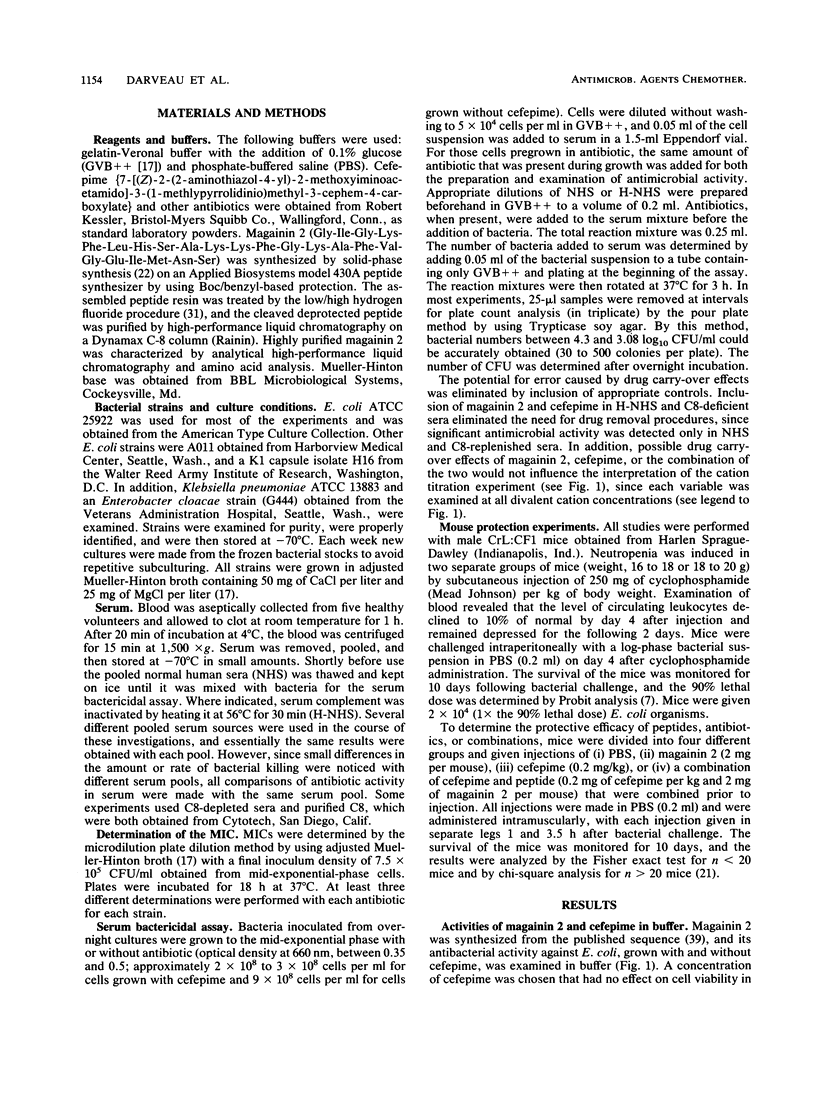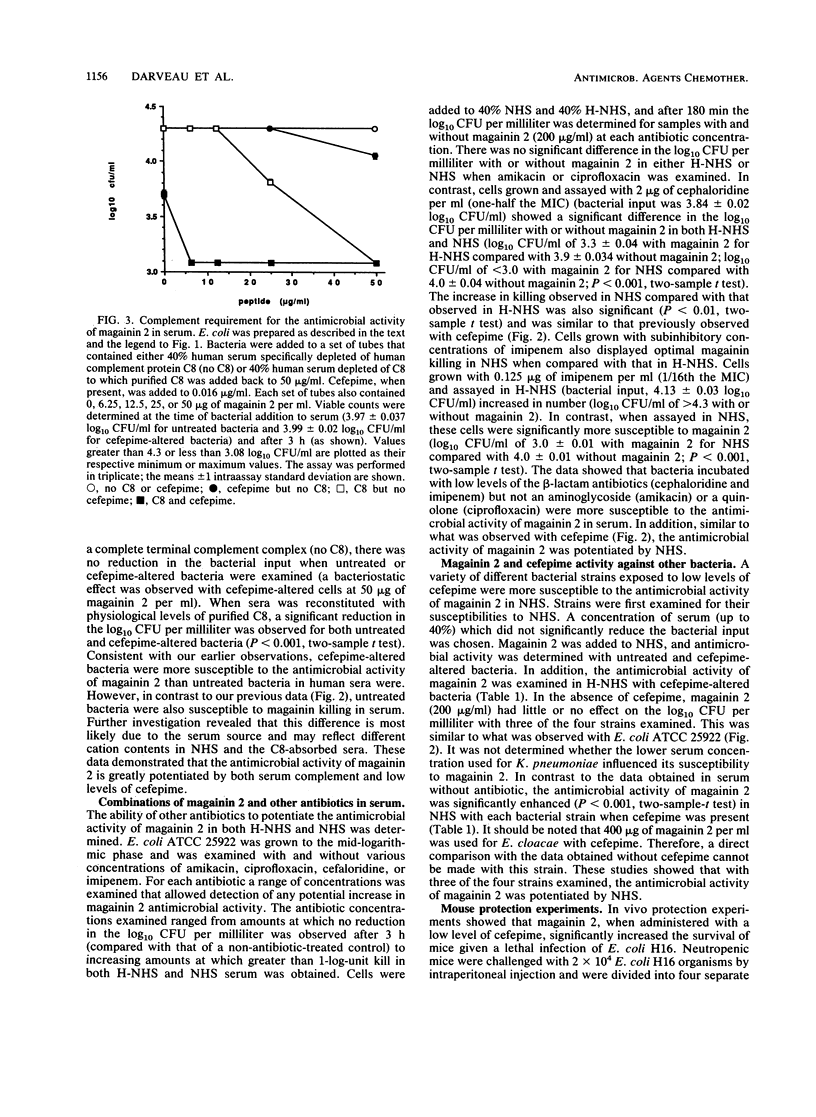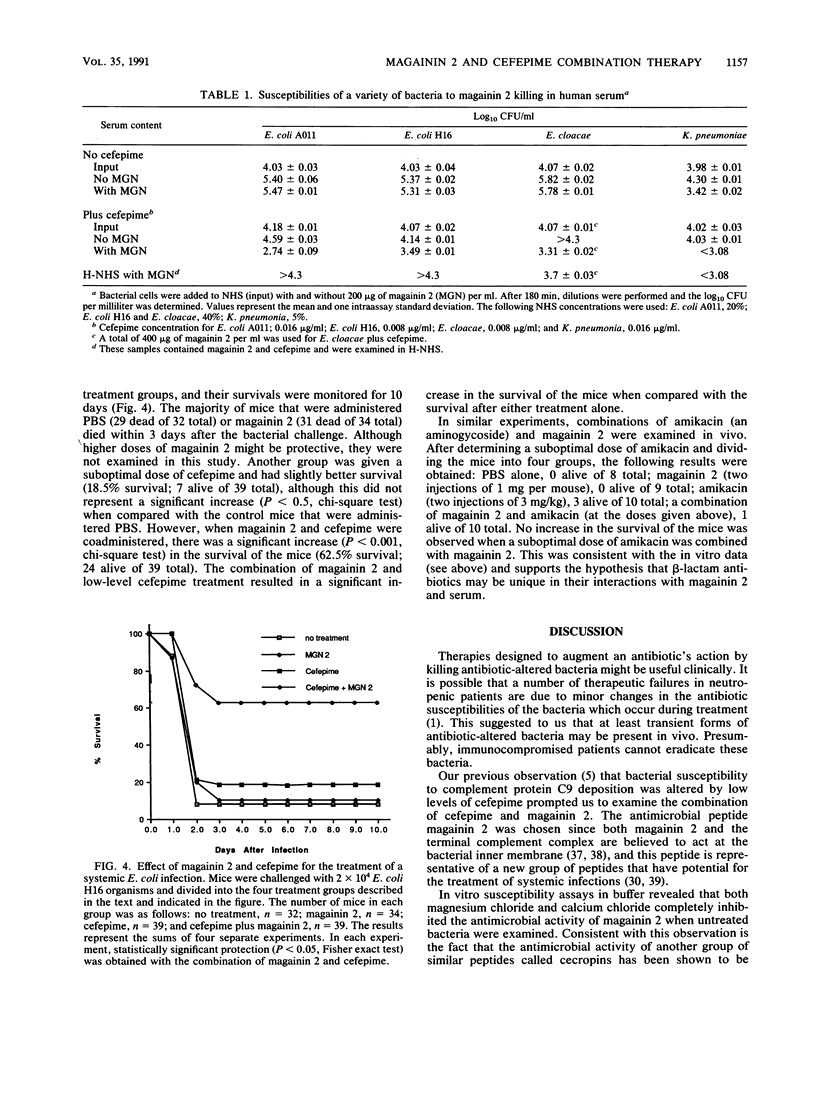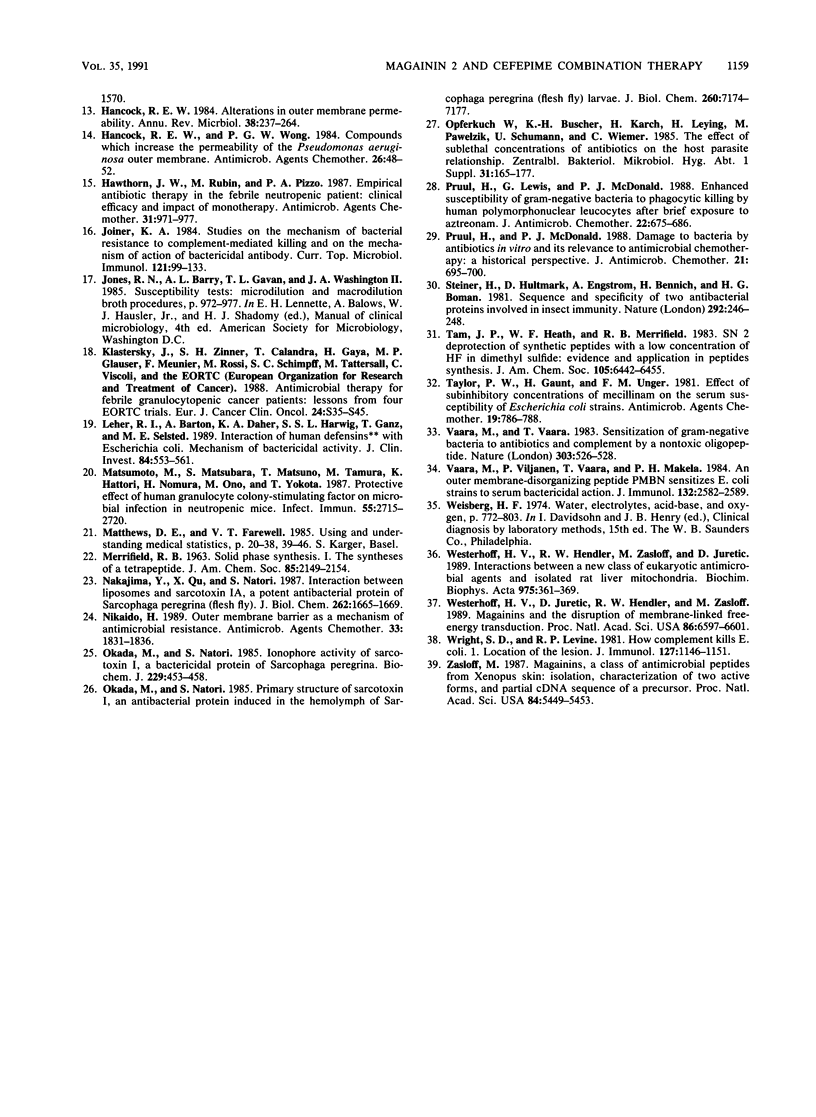Abstract
The ability of magainin 2 to augment antibiotic therapy was examined. Susceptibility to magainin 2 was determined on Escherichia coli incubated in the presence and absence of sublethal concentrations of antibiotics both in vitro and in vivo. Experiments in buffer and normal human serum revealed that E. coli exposed to sublethal amounts of cefepime, a beta-lactam antibiotic, was significantly more susceptible to the antimicrobial activity of magainin 2. Bacteria incubated with subinhibitory concentrations of other beta-lactam type antibiotics, but not amikacin (an aminoglycoside) or ciprofloxacin (a quinolone), were also more susceptible to magainin 2 in normal human serum. Bacteria were less susceptible to magainin 2 when they were examined in heat-inactivated serum. Complement was shown to be required for magainin 2 activity in serum by using C8-deficient sera. The combination of magainin 2 and cefepime was shown to be more antimicrobial in normal human serum for a variety of bacterial strains. Magainin 2 was completely inactive as a therapeutic agent when it was administered alone (2 mg per mouse) but significantly increased the survival of mice when it was administered with a low level of cefepime.
Full text
PDF






Selected References
These references are in PubMed. This may not be the complete list of references from this article.
- Bryan L. E. Two forms of antimicrobial resistance: bacterial persistence and positive function resistance. J Antimicrob Chemother. 1989 Jun;23(6):817–820. doi: 10.1093/jac/23.6.817. [DOI] [PubMed] [Google Scholar]
- Casteels P., Ampe C., Jacobs F., Vaeck M., Tempst P. Apidaecins: antibacterial peptides from honeybees. EMBO J. 1989 Aug;8(8):2387–2391. doi: 10.1002/j.1460-2075.1989.tb08368.x. [DOI] [PMC free article] [PubMed] [Google Scholar]
- Christensen B., Fink J., Merrifield R. B., Mauzerall D. Channel-forming properties of cecropins and related model compounds incorporated into planar lipid membranes. Proc Natl Acad Sci U S A. 1988 Jul;85(14):5072–5076. doi: 10.1073/pnas.85.14.5072. [DOI] [PMC free article] [PubMed] [Google Scholar]
- Darveau R. P., Cunningham M. D. Influence of subinhibitory concentrations of cephalosporins on the serum sensitivity of Pseudomonas aeruginosa. J Infect Dis. 1990 Oct;162(4):914–921. doi: 10.1093/infdis/162.4.914. [DOI] [PubMed] [Google Scholar]
- Fink J., Merrifield R. B., Boman A., Boman H. G. The chemical synthesis of cecropin D and an analog with enhanced antibacterial activity. J Biol Chem. 1989 Apr 15;264(11):6260–6267. [PubMed] [Google Scholar]
- Gabrilove J. L., Jakubowski A., Scher H., Sternberg C., Wong G., Grous J., Yagoda A., Fain K., Moore M. A., Clarkson B. Effect of granulocyte colony-stimulating factor on neutropenia and associated morbidity due to chemotherapy for transitional-cell carcinoma of the urothelium. N Engl J Med. 1988 Jun 2;318(22):1414–1422. doi: 10.1056/NEJM198806023182202. [DOI] [PubMed] [Google Scholar]
- Gennaro R., Skerlavaj B., Romeo D. Purification, composition, and activity of two bactenecins, antibacterial peptides of bovine neutrophils. Infect Immun. 1989 Oct;57(10):3142–3146. doi: 10.1128/iai.57.10.3142-3146.1989. [DOI] [PMC free article] [PubMed] [Google Scholar]
- Grimwood K., To M., Rabin H. R., Woods D. E. Inhibition of Pseudomonas aeruginosa exoenzyme expression by subinhibitory antibiotic concentrations. Antimicrob Agents Chemother. 1989 Jan;33(1):41–47. doi: 10.1128/aac.33.1.41. [DOI] [PMC free article] [PubMed] [Google Scholar]
- Hammer M. C., Baltch A. L., Smith R. P., Conroy J. V., Bishop M., Michelsen P., Hill L. Human granulocyte activity against moxalactam-induced filamentous forms of Pseudomonas aeruginosa. Antimicrob Agents Chemother. 1988 Oct;32(10):1565–1570. doi: 10.1128/aac.32.10.1565. [DOI] [PMC free article] [PubMed] [Google Scholar]
- Hancock R. E. Alterations in outer membrane permeability. Annu Rev Microbiol. 1984;38:237–264. doi: 10.1146/annurev.mi.38.100184.001321. [DOI] [PubMed] [Google Scholar]
- Hancock R. E., Wong P. G. Compounds which increase the permeability of the Pseudomonas aeruginosa outer membrane. Antimicrob Agents Chemother. 1984 Jul;26(1):48–52. doi: 10.1128/aac.26.1.48. [DOI] [PMC free article] [PubMed] [Google Scholar]
- Hathorn J. W., Rubin M., Pizzo P. A. Empirical antibiotic therapy in the febrile neutropenic cancer patient: clinical efficacy and impact of monotherapy. Antimicrob Agents Chemother. 1987 Jul;31(7):971–977. doi: 10.1128/aac.31.7.971. [DOI] [PMC free article] [PubMed] [Google Scholar]
- Joiner K. A. Studies on the mechanism of bacterial resistance to complement-mediated killing and on the mechanism of action of bactericidal antibody. Curr Top Microbiol Immunol. 1985;121:99–133. doi: 10.1007/978-3-642-45604-6_6. [DOI] [PubMed] [Google Scholar]
- Klastersky J., Zinner S. H., Calandra T., Gaya H., Glauser M. P., Meunier F., Rossi M., Schimpff S. C., Tattersall M., Viscoli C. Empiric antimicrobial therapy for febrile granulocytopenic cancer patients: lessons from four EORTC trials. Eur J Cancer Clin Oncol. 1988;24 (Suppl 1):S35–S45. [PubMed] [Google Scholar]
- Lehrer R. I., Barton A., Daher K. A., Harwig S. S., Ganz T., Selsted M. E. Interaction of human defensins with Escherichia coli. Mechanism of bactericidal activity. J Clin Invest. 1989 Aug;84(2):553–561. doi: 10.1172/JCI114198. [DOI] [PMC free article] [PubMed] [Google Scholar]
- Matsumoto M., Matsubara S., Matsuno T., Tamura M., Hattori K., Nomura H., Ono M., Yokota T. Protective effect of human granulocyte colony-stimulating factor on microbial infection in neutropenic mice. Infect Immun. 1987 Nov;55(11):2715–2720. doi: 10.1128/iai.55.11.2715-2720.1987. [DOI] [PMC free article] [PubMed] [Google Scholar]
- Nakajima Y., Qu X. M., Natori S. Interaction between liposomes and sarcotoxin IA, a potent antibacterial protein of Sarcophaga peregrina (flesh fly). J Biol Chem. 1987 Feb 5;262(4):1665–1669. [PubMed] [Google Scholar]
- Nikaido H. Outer membrane barrier as a mechanism of antimicrobial resistance. Antimicrob Agents Chemother. 1989 Nov;33(11):1831–1836. doi: 10.1128/aac.33.11.1831. [DOI] [PMC free article] [PubMed] [Google Scholar]
- Okada M., Natori S. Ionophore activity of sarcotoxin I, a bactericidal protein of Sarcophaga peregrina. Biochem J. 1985 Jul 15;229(2):453–458. doi: 10.1042/bj2290453. [DOI] [PMC free article] [PubMed] [Google Scholar]
- Okada M., Natori S. Primary structure of sarcotoxin I, an antibacterial protein induced in the hemolymph of Sarcophaga peregrina (flesh fly) larvae. J Biol Chem. 1985 Jun 25;260(12):7174–7177. [PubMed] [Google Scholar]
- Pruul H., Lewis G., McDonald P. J. Enhanced susceptibility of gram-negative bacteria to phagocytic killing by human polymorphonuclear leucocytes after brief exposure to aztreonam. J Antimicrob Chemother. 1988 Nov;22(5):675–686. doi: 10.1093/jac/22.5.675. [DOI] [PubMed] [Google Scholar]
- Pruul H., McDonald P. J. Damage to bacteria by antibiotics in vitro and its relevance to antimicrobial chemotherapy: a historical perspective. J Antimicrob Chemother. 1988 Jun;21(6):695–698. doi: 10.1093/jac/21.6.695. [DOI] [PubMed] [Google Scholar]
- Steiner H., Hultmark D., Engström A., Bennich H., Boman H. G. Sequence and specificity of two antibacterial proteins involved in insect immunity. Nature. 1981 Jul 16;292(5820):246–248. doi: 10.1038/292246a0. [DOI] [PubMed] [Google Scholar]
- Taylor P. W., Gaunt H., Unger F. M. Effect of subinhibitory concentrations of mecillinam on the serum susceptibility of Escherichia coli strains. Antimicrob Agents Chemother. 1981 May;19(5):786–788. doi: 10.1128/aac.19.5.786. [DOI] [PMC free article] [PubMed] [Google Scholar]
- Vaara M., Vaara T. Sensitization of Gram-negative bacteria to antibiotics and complement by a nontoxic oligopeptide. Nature. 1983 Jun 9;303(5917):526–528. doi: 10.1038/303526a0. [DOI] [PubMed] [Google Scholar]
- Vaara M., Viljanen P., Vaara T., Mäkelä P. H. An outer membrane-disorganizing peptide PMBN sensitizes E. coli strains to serum bactericidal action. J Immunol. 1984 May;132(5):2582–2589. [PubMed] [Google Scholar]
- Westerhoff H. V., Hendler R. W., Zasloff M., Juretić D. Interactions between a new class of eukaryotic antimicrobial agents and isolated rat liver mitochondria. Biochim Biophys Acta. 1989 Aug 3;975(3):361–369. doi: 10.1016/s0005-2728(89)80344-5. [DOI] [PubMed] [Google Scholar]
- Westerhoff H. V., Juretić D., Hendler R. W., Zasloff M. Magainins and the disruption of membrane-linked free-energy transduction. Proc Natl Acad Sci U S A. 1989 Sep;86(17):6597–6601. doi: 10.1073/pnas.86.17.6597. [DOI] [PMC free article] [PubMed] [Google Scholar]
- Wright S. D., Levine R. P. How complement kills E. coli. I. Location of the lethal lesion. J Immunol. 1981 Sep;127(3):1146–1151. [PubMed] [Google Scholar]
- Zasloff M. Magainins, a class of antimicrobial peptides from Xenopus skin: isolation, characterization of two active forms, and partial cDNA sequence of a precursor. Proc Natl Acad Sci U S A. 1987 Aug;84(15):5449–5453. doi: 10.1073/pnas.84.15.5449. [DOI] [PMC free article] [PubMed] [Google Scholar]


